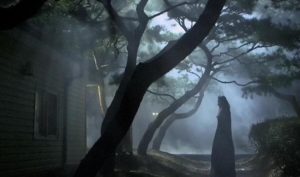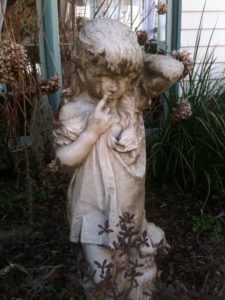 Founded in 1824, Pilgrim Hall is the oldest public museum in continuous operation in the United State. Several years back, I spoke before a gathering of its membership. My knees were shaking. I was surrounded by historic artifacts: Myles Standish’s sword, the cradle of the first child born in New England, and massive paintings that soared from floor to ceiling. And in this hallowed hall I was about to give a talk about ghosts to a conservative, erudite assemblage of individuals dedicated to preserving the early history of our country. Thought to self: This is not a good idea.
Founded in 1824, Pilgrim Hall is the oldest public museum in continuous operation in the United State. Several years back, I spoke before a gathering of its membership. My knees were shaking. I was surrounded by historic artifacts: Myles Standish’s sword, the cradle of the first child born in New England, and massive paintings that soared from floor to ceiling. And in this hallowed hall I was about to give a talk about ghosts to a conservative, erudite assemblage of individuals dedicated to preserving the early history of our country. Thought to self: This is not a good idea.
One astounding hour later, I still had their attention. I began with a tale of a trio of ghosts at the Orleans Inn (The Haunting of Cape Cod and the Islands/Chapter 16). The inn was built by a sea captain in 1875 whose lineage traces back to Mayflower passenger Constance Hopkins Snow. However, the three ghosts who haunt the inn today sadly, have little in common with the Mayflower or the Pilgrims. It seemed to work as they even chuckled when I related that one of the ghosts, Hannah, a women of questionable virtue, is known to dance naked in the belvedere on top of the inn.

Next, I hit them with a mysterious glassmaker, Adolph Bonique, who could conjure life into a glass flower; the flower would unfold with the rays of the sun and give off a sweet perfume. Adolph was one of the early glassmakers at the Sandwich Glass Factory opened in 1825. And on foggy nights in the town of Sandwich, Massachusetts, the phantom of a man can be seen walking the streets of old town carrying a golden glass cane.
I began to wrap things up with the tale of pirate Black Sam Bellamy and the wreck of his vessel off the coast of Cape Cod in 1717. Although, this true story has several alternate endings, each version concludes with the ghosts of Sam and his mistress wandering the beach near Wellfleet. I left my astute audience with the love story of Captain Ebenezer Linnell and his wife, the golden-haired Rebecca. In 1864, Eben met a horrific end; on his last voyage, a storm threw the captain into the ship’s wheel, a spoke from the wheel punctured his lungs. He was buried at sea. Rebecca learned of his death from a letter from the ship’s first mate. For the next sixty years, Rebecca climbed the steps of the cupola of the home Eben built for her. In the copula, she read and reread the letter describing her beloved’s death. She never remarried. Today, visitors to the Captain Linnell House Restaurant, swear they still see the figure of Rebecca in the cupola wistfully looking out to sea.
With that daunting talk at a prestigious museum successfully behind me, I didn’t flinch when the president of a Catholic women’s club asked me to speak before her group – at the church. Previously, during my production of the PBS documentary, The Haunting of Louisiana, I had been told unequivocally by a Catholic moral theologian, “There is no such thing as ghosts. Ghosts can’t just pop in & out like they are on some divine elevator.”
But, once again, I embarked on an hour-long presentation before a group who did not believe in the existence of ghosts. I relayed the quote from the Catholic moral theologian and his stance’s in opposition to the topic, and then countered with the belief of the Archbishop of the Israelite Divine Spiritual Church: “If you pray hard enough, and the Holy Ghost takes you. You can communicate with spirits; there are times you can see them and they can appear in many disguises.”
Before there were any objections, I proceeded to share a tale of the reputedly very haunted 1716 Barnstable House. A fire in the 1970s brought out one spirit. According to newspaper accounts and the local fire department when the fire trucks arrived smoke was billowing from the third story attic windows. A fireman spotted a woman in the window with long white hair and rushed up the stairs to save her. He was unable to find her; the attic was empty. After the fire was contained, another fireman was wrapping up the hoses when he was approached by a woman. He thought it odd that she was outside without a coat on such a snowy evening. He was about to suggest she find warmer attire when he glanced down at her bare feet and saw the she was levitating about a foot off the ground.
Then I launched into one of my favorites: The Excessive Compulsive Exhorter ((The Haunting of Cape Cod and the Islands/Chapter 19). I was hoping my audience would relate to a religious figure who dedicated his life to urging people to give their lives to God. Exhorter Stephen Collins was obsessed with getting to church on time. The First Congregational Church in Truro sat on a hill, so Stephen got a horse to race to the top. On one fateful Communion Sunday, the frantic preacher was blind to others slowly making their way up. Consumed with anxiety, Stephen did not see a crippled young boy. He trampled Silas and raced on believing others would pick the boy back up. At the church, the congregation carried the crumpled body of the young lad to the front pew. At the end of the service, Stephen left never to enter the church again. On subsequent Sabbaths, Stephen would stand outside the church and then scurry over to the Burying Acre and kneel before the fresh grave of Silas. On his death the forgiving congregation buried him beside the church. His tortured spirit cannot rest. For even today, the Exhorter’s spirit returns riding a phantom horse. Locals claim they hear the labored wheezing of a horse and hoofs pounding. The ghostly rider dismounts and kneels before a worn headstone, the inscription now illegible to the human eye. His lips move soundlessly in prayer. He remounts and disappears into the night.

So many years apart, my audiences, both at the revered museum and at the church listened in quiet solemnity to these haunted tales. Through the question and answer periods that followed, I learned they were eager to learn more about those who walked the paths of Cape Cod before them. They acknowledged that such tales keep the past alive, and are meant to be shared.
A fervent Yea to the retelling of all such tales.


